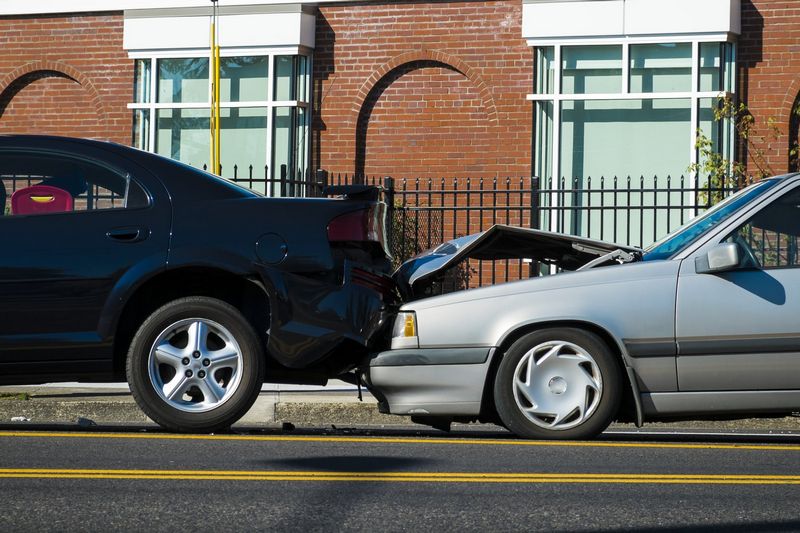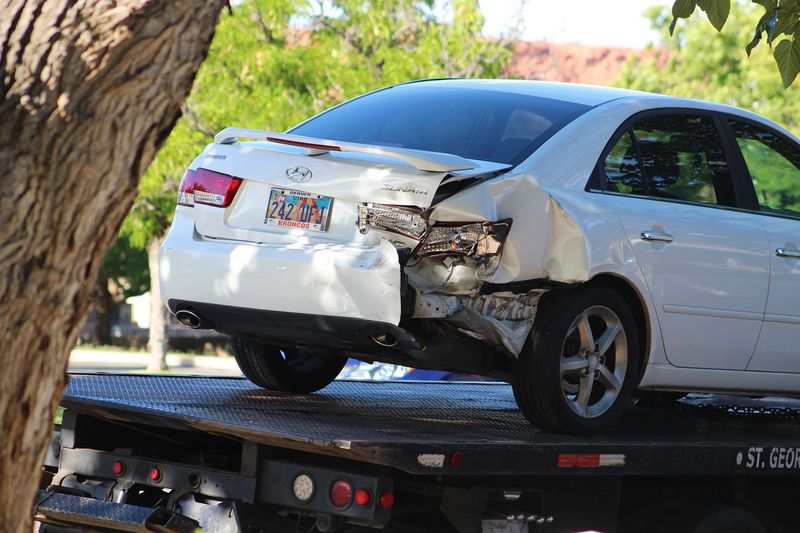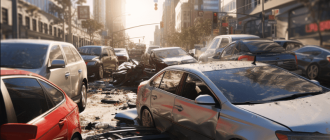
Car Problems That Can Occur After a Rear End Collision
Being involved in a car collision is a stressful experience, especially if it’s a rear end collision. While the severity of the impact may vary, there are common problems that can occur after such an incident. Knowing what to expect can help you navigate the aftermath of a rear end collision more effectively.
One of the most common car problems after a rear end collision is damage to the rear bumper. Rear bumpers are designed to absorb the impact and protect the rest of the vehicle. However, in a significant collision, the bumper may crack, dent, or even detach from the car altogether. This can leave your car vulnerable to further damage and compromise its structural integrity.
In addition to bumper damage, rear end collisions can also cause issues with your car’s alignment. The force of the impact can knock your car out of alignment, resulting in uneven tire wear and difficulty in steering. It’s important to have your car’s alignment checked and adjusted if necessary to prevent further damage and ensure a safe driving experience.
Another problem that can occur after a rear end collision is damage to the trunk or rear storage area of your car. Depending on the severity of the collision, the trunk may become dented, warped, or even unlatch. This can make it difficult to open or close the trunk properly and may also expose your belongings to the elements.
It’s important to remember that not all car problems after a rear end collision may be immediately visible. Internal damage to your car’s engine, transmission, or other vital components can occur without any noticeable signs. Therefore, it’s crucial to have your car thoroughly inspected by a qualified mechanic to ensure its safety and functionality.
Car Problems After Rear End Collision: Expectations
After a rear-end collision, there are several problems that can occur with your car. These problems may not be immediately noticeable, so it’s important to be aware of what to expect after such an incident.
- Damage to the Rear End: The most obvious problem that can occur after a rear-end collision is damage to the rear of your car. This can include dents, scratches, or even more serious structural damage.
- Alignment Issues: The impact of a rear-end collision can cause your car’s alignment to be thrown off. This can result in problems with tire wear and handling, and may require realignment.
- Transmission Problems: The jolt from a rear-end collision can also cause damage to your car’s transmission. Shifting gears may become difficult or not function properly.
- Electrical Issues: Rear-end collisions can also cause electrical problems in your car. This can result in issues with your lights, sensors, or other electronic components.
- Brake Problems: The impact from a rear-end collision can put a lot of stress on your car’s braking system. It’s important to check for proper brake functionality following such an incident.
It’s also important to note that these problems can vary depending on the severity of the collision. Even minor rear-end accidents can cause damage that may not be immediately apparent. It’s always a good idea to have your car thoroughly inspected by a professional after a rear-end collision to ensure that all potential problems are identified and addressed.
Frame and Body Damage
When a rear-end collision occurs, it is common for the rear end of the car to sustain damage. This can result in significant problems, particularly with the frame and body of the vehicle.
Frame Damage:
- If the rear-end collision is severe enough, it can cause damage to the frame of the car. The frame is the structural backbone of the vehicle and any damage to it can compromise the safety and structural integrity of the car.
- Frame damage can lead to alignment issues, making the car difficult to drive and causing uneven tire wear. It can also affect the overall performance and handling of the vehicle.
- Repairing frame damage can be expensive and time-consuming. In some cases, it may even be necessary to replace the entire frame of the car.
Body Damage:
- In addition to frame damage, a rear-end collision can also cause significant damage to the body of the car.
- Body damage may include dents, scratches, and even punctures in the car’s exterior.
- If left unrepaired, body damage can lead to rust and corrosion, decreasing the value and appearance of the vehicle.
- Repairing body damage typically involves techniques such as painting, dent removal, and panel replacement.
Insurance coverage:
It’s important to note that frame and body damage resulting from a rear-end collision may not always be fully covered by insurance. Some policies have limitations on coverage for damage that is considered “cosmetic” or “non-structural.”
It is always recommended to consult with your insurance provider to understand the extent of coverage for frame and body damage after a rear-end collision.
Alignment Issues
After a rear end collision, alignment issues are common car problems that can occur. The force from the impact can cause the wheels to shift or become misaligned, resulting in a variety of issues.
Signs of alignment issues
- Vehicle pulling to one side: If your car drifts to one side even when the steering wheel is straight, it is a sign of misalignment.
- Uneven tire wear: Misalignment can cause uneven tire wear, which can be seen as excessive wear on the inside or outside edges of the tires.
- Steering wheel vibration: If your steering wheel vibrates while driving, it can be a result of misaligned wheels.
- Off-center steering wheel: If your steering wheel is not centered when driving straight, it indicates alignment issues.
Effects of alignment issues
Alignment issues can have several effects on your car’s performance:
- Handling problems: Misaligned wheels can affect the handling of your car, making it difficult to steer and control.
- Poor fuel efficiency: Misalignment can cause your tires to drag, increasing resistance and decreasing fuel efficiency.
- Tire damage: Uneven tire wear can lead to premature tire damage, requiring frequent replacements.
- Safety concerns: Driving with misaligned wheels can compromise your car’s stability and increase the risk of accidents.
Getting alignment issues fixed
If you experience any signs of alignment issues after a rear end collision, it is essential to get your car inspected and aligned by a professional. They will use specialized equipment to assess the alignment and make necessary adjustments to ensure your car is back in proper alignment.
| 1 | Find a reputable auto repair shop. |
| 2 | Explain the alignment issues you are experiencing. |
| 3 | Schedule an appointment for an alignment check. |
| 4 | During the alignment, the technician will measure and adjust the angles of the wheels to bring them back to the manufacturer’s specifications. |
| 5 | After the alignment, test drive your car to ensure the issues have been resolved. |
By addressing alignment issues promptly, you can prevent further damage to your car’s tires and improve its overall performance and safety.
Suspension Problems
Suspension problems are a common issue that can occur after a rear end collision. When a car is rear-ended, the impact can cause damage to the suspension system, which is responsible for maintaining the stability and control of the vehicle.
Some common suspension problems that can arise after a rear end collision include:
- Bent or damaged control arms: The control arms are responsible for connecting the wheels to the frame of the car. If they become bent or damaged in a rear end collision, it can affect the alignment and handling of the vehicle.
- Broken springs: The springs in the suspension system help to absorb shocks and provide a smooth ride. However, a rear end collision can cause the springs to break or become damaged, resulting in a bumpy or uncomfortable ride.
- Leaking shocks: The shocks in the suspension system help to absorb bumps and vibrations. If they become damaged in a rear end collision, they can start to leak fluid, which can affect the overall performance of the suspension system.
- Misaligned wheels: A rear end collision can cause the wheels to become misaligned, which can lead to uneven tire wear and poor handling. This can make it difficult to steer the vehicle properly.
If you experience any of these suspension problems after a rear end collision, it is important to have your vehicle inspected by a professional mechanic. They will be able to assess the extent of the damage and make the necessary repairs to ensure that your car is safe to drive.
Brake System Damage
After a rear-end collision, several problems can occur with a car’s brake system due to the impact. Even though the brakes might not be directly involved in the collision, the force generated can still cause damage. It’s crucial to have a thorough inspection to ensure your vehicle is safe to drive.

Here are a few common brake system issues that can arise after a rear-end collision:
- Brake Fluid Leaks: The impact from the collision can cause brake lines to become disconnected or damaged, resulting in brake fluid leaks. Leaking brake fluid can lead to a loss of hydraulic pressure and affect the overall braking performance.
- Warped Brake Rotors: The sudden impact from a rear-end collision can cause the brake rotors to warp. Warped rotors can lead to vibrations, decreased braking efficiency, and increased stopping distances.
- Brake Pad Damage: The force applied during a rear-end collision can cause damage to the brake pads. Cracked or worn-out brake pads may not provide sufficient friction, affecting the braking power.
- Caliper Misalignment: A rear-end collision can knock the brake calipers out of alignment, causing uneven brake pad wear and reduced braking performance. Misaligned calipers can result in a pulling sensation or uneven braking from side to side.
If you experience any of these problems after a rear-end collision, it’s important to have your brake system inspected by a qualified mechanic. They will be able to identify any damage and recommend the necessary repairs or replacements. Keep in mind that driving with a damaged brake system can put your safety at risk, so it’s crucial to address these issues promptly.
Remember, even if your car appears to be working normally after a rear-end collision, it’s recommended to have a professional inspection to ensure there are no hidden brake system problems. Your safety and the safety of others on the road should always be your top priority.
Electrical Malfunctions
After a rear-end collision, various electrical malfunctions can occur in a car. Due to the impact from the collision, wiring and electrical components in the rear of the vehicle may be damaged or dislodged, leading to a range of electrical problems.
One common electrical issue that can arise after a rear-end collision is a malfunctioning tail light. The force of impact can cause the bulbs or the wiring connecting them to become damaged or disconnected. As a result, the tail light may not work properly or may not work at all. This can be a safety hazard as it affects the visibility of the vehicle to other drivers on the road.
Another common electrical problem that can occur after a rear-end collision is a malfunctioning reverse light. Similar to the tail light, the reverse light can be damaged or disconnected due to the impact. This can make it difficult for the driver to see when reversing, increasing the risk of accidents.
In addition to external lighting issues, electrical malfunctions can also affect the car’s internal systems. For example, the collision can cause damage to the car’s electrical control unit, which is responsible for controlling various functions such as the engine, transmission, and braking system. If this unit is damaged, it can lead to a range of problems, including engine misfires, transmission issues, or even complete failure of the car’s systems.
It is important to note that not all electrical malfunctions will be immediately apparent after a rear-end collision. Some problems may only become apparent after a certain amount of time or under specific conditions. Therefore, it is important to have the car thoroughly inspected by a qualified mechanic to identify and address any potential electrical issues that may arise as a result of the collision.
Transmission Issues
After a rear-end collision, several car problems can occur, and transmission issues are one of them. The transmission is responsible for transferring power from the engine to the wheels, allowing the car to move.
If your car experiences a rear-end collision, it can cause damage to the transmission system. The impact from the collision can result in a variety of transmission problems, including:
- Fluid Leaks: The impact of a rear-end collision can cause damage to the transmission housing, resulting in fluid leaks. This can lead to a loss of transmission fluid, which can cause the transmission to overheat and potentially fail.
- Shifting Problems: A rear-end collision can damage the shift linkage or the solenoids that control the shifting of gears. This can result in difficulty shifting gears, hesitation, or the transmission getting stuck in a specific gear.
- Slipping Gears: The impact can also cause the internal gears of the transmission to become misaligned or damaged. This can lead to the transmission slipping out of gear or shifting unexpectedly while driving.
- Delayed Engagement: Rear-end collisions can cause damage to the transmission’s torque converter, which can result in delayed or sluggish engagement when the car is put into gear.
- Loss of Power: In some cases, a rear-end collision can cause damage to the transmission’s internal components, resulting in a loss of power and decreased performance.
If you experience any of these transmission problems after a rear-end collision, it is important to have your car inspected by a qualified mechanic. They will be able to assess the extent of the damage and recommend necessary repairs or replacements.
Engine Problems
After a rear end collision, it is common for car engine problems to occur. The impact of the collision can cause damage to the engine, resulting in various issues that need to be addressed.
1. Engine Misalignment: The force from the rear end collision can cause the engine to shift out of its proper position. This misalignment can lead to engine vibration, reduced performance, and even engine failure if not corrected.
2. Transmission Damage: The transmission is another component that can be affected by a rear end collision. The impact can damage the transmission, causing it to malfunction or fail altogether. This can result in difficulty shifting gears, slipping gears, or complete transmission failure.
3. Coolant Leaks: The collision can cause damage to the radiator or other cooling system components, leading to coolant leaks. If coolant leaks occur, the engine can overheat and potentially cause further damage if not addressed promptly.
4. Electrical Issues: The force of the collision can cause damage to the electrical system, affecting various engine components. This can result in issues such as difficulty starting the engine, malfunctioning sensors, or problems with the ignition system.
5. Fuel System Damage: The fuel system can also be impacted by a rear end collision. Damage to the fuel tank or fuel lines can result in fuel leaks, which can be a fire hazard and can also cause the engine to run poorly or not start at all.
It is important to have your car inspected by a qualified mechanic after a rear end collision to determine if any engine problems have occurred. Prompt repairs can help prevent further damage and ensure the safe operation of your vehicle.
Exhaust System Damage
After a rear-end collision, it is common for the exhaust system of the car to sustain damage. The exhaust system plays a vital role in a vehicle’s performance and safety, as it helps to remove harmful gases and reduces noise pollution. However, when a car is rear-ended, several problems can occur in the exhaust system.
1. Exhaust Pipe Damage: The exhaust pipe, which carries exhaust gases from the engine to the rear of the car, can be damaged in a rear-end collision. It may crack, bend, or even break completely, causing leaks and reduced exhaust flow.
2. Muffler and Resonator Damage: The muffler and resonator, which are responsible for reducing exhaust noise, can also be affected. They may get dented, punctured, or detached, causing an increase in noise level and decreased efficiency in noise reduction.
3. Catalytic Converter Damage: The catalytic converter, which helps to reduce harmful emissions by converting them into less harmful substances, can be damaged in a rear-end collision. It may get crushed or clogged, leading to reduced performance and increased emissions.
4. Hangers and Mounts Damage: The hangers and mounts that support and secure the exhaust system in place can also be damaged. They may get bent, broken, or detached, causing the exhaust system to hang lower or drag on the ground, posing a safety risk.
5. Joint and Seal Damage: The joints and seals that connect different parts of the exhaust system can get damaged or loosened. This can result in leaks, leading to decreased efficiency, increased noise, and potential damage to other components.
It is important to have the exhaust system thoroughly inspected by a professional after a rear-end collision. They can assess the extent of the damage and determine the necessary repairs or replacements. Driving a car with a damaged exhaust system can not only affect its performance but also pose a risk to the driver and passengers due to increased emissions and potential safety hazards.
Fuel System Complications
After a rear-end collision, a car’s fuel system can experience various problems. Here are some common complications that can occur:
- Fuel Leaks: Rear-end collisions can damage the fuel tank or fuel lines, leading to leaks. This is a serious problem that can pose a fire hazard and should be addressed immediately.
- Fuel Pump Issues: The impact from a rear-end collision can damage the fuel pump, causing it to malfunction or fail. This can result in a lack of fuel pressure, which can prevent the car from starting or cause it to stall while driving.
- Clogged Fuel Filters: The force of a rear-end collision can dislodge debris and contaminants in the fuel system, causing them to clog the fuel filters. This can result in a restricted flow of fuel to the engine, leading to performance issues such as sputtering or stalling.
- Contaminated Fuel: If the fuel tank is breached during a rear-end collision, it can allow foreign substances, such as water or debris, to enter the fuel system. This can lead to engine damage and poor fuel efficiency.
- Electrical Problems: A rear-end collision can cause damage to the electrical wiring and connections associated with the fuel system. This can result in issues such as faulty fuel level sensors, inaccurate fuel gauges, or problems with the fuel pump relay.
It is important to have a qualified mechanic inspect the fuel system after a rear-end collision to identify and address any problems. Ignoring or neglecting fuel system complications can lead to further damage and potentially unsafe driving conditions.
Cooling System Concerns
After a rear-end collision, there are several common car problems that can occur, and one area that is often affected is the cooling system. The cooling system plays a critical role in maintaining the engine’s temperature and preventing overheating. Here are some cooling system concerns you may experience after a collision:
- Leaking coolant: Rear-end collisions can cause damage to the radiator or coolant hoses, leading to coolant leaks. Leaking coolant can result in engine overheating and potential damage if not addressed promptly.
- Impaired radiator functionality: A rear-end collision can damage the radiator, impacting its ability to cool the engine efficiently. This can lead to engine overheating and potential engine damage if left unresolved.
- Damaged cooling fan: The impact of a rear-end collision can damage the cooling fan or its components. A malfunctioning or damaged cooling fan can result in inadequate airflow, leading to engine overheating.
- Thermostat issues: The thermostat regulates the flow of coolant through the engine. After a collision, the thermostat may become damaged or malfunction, affecting the engine’s temperature regulation and potentially leading to overheating.
- Cracked or damaged coolant reservoir: The coolant reservoir can sustain damage in a rear-end collision, resulting in cracks or leaks. A compromised coolant reservoir can lead to coolant loss and subsequent engine overheating.
If you have been involved in a rear-end collision, it is essential to have your cooling system inspected by a professional. They will be able to identify any potential issues and make the necessary repairs to ensure your car’s cooling system is working properly. Ignoring cooling system concerns after a collision can result in further damage to your vehicle’s engine and costly repairs.
Interior Damage
After a rear-end collision, a car can experience various problems not only on the exterior, but also on the interior. The impact from the rear can cause damage that may not be immediately visible, but could lead to issues down the line.
1. Seat Damage: The force of the collision can cause the seats to break or become misaligned. This can make them uncomfortable to sit on and may require repairs or even replacement.
2. Seatbelt Malfunction: The seatbelts are designed to protect occupants during a collision, but they can also become damaged in the process. If the seatbelt no longer functions properly, it may need to be repaired or replaced to ensure the safety of the passengers.
3. Airbag Deployment: In some cases, the force of a rear-end collision can cause the airbags to deploy. While this is an important safety feature, it can also lead to interior damage. The airbags may need to be replaced, and any components such as the dashboard or steering wheel that were impacted by their deployment may also require repair.
4. Electrical Issues: The impact from a rear-end collision can cause wiring and electrical components in the interior of the car to become damaged. This can result in issues such as malfunctioning lights, power windows, or door locks. A specialized mechanic may need to inspect and repair the electrical system to ensure proper functioning.
5. Carpet and Upholstery: The force of the collision can cause carpets to become stained or torn, and upholstery to become ripped or dislodged. These damages may seem minor, but they can affect the overall comfort and appearance of the car.
6. Storage Compartment Damage: Interior storage compartments, such as the center console or glove box, can be impacted by a rear-end collision. The force of the impact can cause them to become misaligned, broken, or difficult to open and close.
It is important to have a professional inspection of your car after a rear-end collision to identify any interior damage that may not be immediately noticeable. By addressing these issues promptly, you can ensure the safety, functionality, and appearance of your vehicle for years to come.
FAQ:
What are some common car problems that can occur after a rear-end collision?
Some common car problems that can occur after a rear-end collision include damage to the bumper, frame, or rear lights, as well as alignment issues and potential damage to the exhaust system.
How can I tell if there is damage to the frame of my car after a rear-end collision?
If there is damage to the frame of your car after a rear-end collision, you may notice misalignment of the body panels, uneven gaps between the doors and fenders, or difficulty in opening and closing the doors.
What should I do if the rear lights of my car are damaged in a rear-end collision?
If the rear lights of your car are damaged in a rear-end collision, you should have them replaced as soon as possible. Not only can damaged rear lights affect your visibility on the road, but they can also result in a citation or fine from law enforcement.
Can a rear-end collision cause damage to the exhaust system of a car?
Yes, a rear-end collision can cause damage to the exhaust system of a car. If the rear of your car suffers significant impact, it is possible for the exhaust system to become bent, dented, or disconnected, leading to issues such as increased noise, decreased performance, or potential leaks.
What can I do if my car’s alignment is off after a rear-end collision?
If your car’s alignment is off after a rear-end collision, you should take it to a professional mechanic or body shop to have it inspected and realigned if necessary. Ignoring alignment issues can lead to uneven tire wear, decreased fuel efficiency, and impaired handling and stability on the road.
What are some common car problems after a rear end collision?
After a rear end collision, some common car problems include damage to the bumper, trunk, or rear lights, misalignment of the wheels, suspension damage, and potential damage to the frame of the car.




